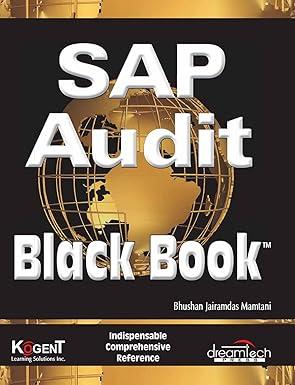Answered step by step
Verified Expert Solution
Question
1 Approved Answer
E3-16 Zac Brown Company has the following balances in selected accounts on December 31, 2017. Service Revenue $40,000 Insurance Expense 2,700 Supplies Expense 2,450 All
E3-16 Zac Brown Company has the following balances in selected accounts on December 31, 2017.
Service Revenue $40,000
Insurance Expense 2,700
Supplies Expense 2,450
All the accounts have normal balances. Zac Brown Company debits prepayments to expense accounts when paid, and credits unearned revenues to revenue accounts when received. The following information below has been gathered at December 31, 2017.
Zac Brown Company paid $2,700 for 12 months of insurance coverage on June 1, 2017.
On December 1, 2017, Zac Brown Company collected $40,000 for consulting services to be performed from December 1, 2017, through March 31, 2018.
A count of supplies on December 31, 2017, indicates that supplies of $900 are on hand.
Instructions
Prepare the adjusting entries needed at December 31, 2017.
Journalize transactions and adjusting entries.
(LO 5)
*E3-17 At Sekon Company, prepayments are debited to expense when paid, and unearned revenues are credited to revenue when cash is received. During January of the current year, the following transactions occurred.
Jan. 2 Paid $1,920 for fire insurance protection for the year.
10 Paid $1,700 for supplies.
15 Received $6,100 for services to be performed in the future.
On January 31, it is determined that $2,100 of the services were performed and that there are $650 of supplies on hand.
Instructions
(a) Journalize and post the January transactions. (Use T-accounts.)
(b) Journalize and post the adjusting entries at January 31.
(c) Determine the ending balance in each of the accounts.
Identify accounting assumptions and principles.
(LO 6)
*E3-18 Presented below are the assumptions and principles discussed in this chapter.
Full disclosure principle.
Going concern assumption.
Monetary unit assumption.
Time period assumption.
Historical cost principle.
Economic entity assumption.
Instructions
Identify by number the accounting assumption or principle that is described below. Do not use a number more than once.
______(a) Is the rationale for why plant assets are not reported at liquidation value. (Note: Do not use the historical cost principle.)
______(b) Indicates that personal and business record-keeping should be separately maintained.
______(c) Assumes that the monetary unit is the measuring stick used to report on financial performance.
______(d) Separates financial information into time periods for reporting purposes.
______(e) Measurement basis used when a reliable estimate of fair value is not available.
______(f) Dictates that companies should disclose all circumstances and events that make a difference to financial statement users.
Identify the assumption or principle that has been violated.
(LO 6)
*E3-19 Weber Co. had three major business transactions during 2017.
(a) Reported at its fair value of $260,000 merchandise inventory with a cost of $208,000.
(b) The president of Weber Co., Austin Weber, purchased a truck for personal use and charged it to his expense account.
(c) Weber Co. wanted to make its 2017 income look better, so it added 2 more weeks to the year (a 54-week year). Previous years were 52 weeks.
Instructions
In each situation, identify the assumption or principle that has been violated, if any, and discuss what the company should have done.
Identity financial accounting concepts and principles.
(LO 6)
*E3-20 The following characteristics, assumptions, principles, or constraint guide the FASB when it creates accounting standards.
RelevanceExpense recognition principle
Faithful representationTime period assumption
ComparabilityGoing concern assumption
ConsistencyHistorical cost principle
Monetary unit assumptionFull disclosure principle
Economic entity assumptionMateriality
Match each item above with a description below.
___ Ability to easily evaluate one company's results relative to another's.
___ Belief that a company will continue to operate for the foreseeable future.
___ The judgment concerning whether an item's size is large enough to matter to decision-makers.
___ The reporting of all information that would make a difference to financial statement users.
___ The practice of preparing financial statements at regular intervals.
___ The quality of information that indicates the information makes a difference in a decision.
___ A belief that items should be reported on the balance sheet at the price that was paid to acquire them.
___ A company's use of the same accounting principles and methods from year to year.
___ Tracing accounting events to particular companies.
___ The desire to minimize bias in financial statements.
___ Reporting only those things that can be measured in monetary units.
___ Dictates that efforts (expenses) be matched with results (revenues).
Comment on the objective and qualitative characteristics of accounting information.
Step by Step Solution
There are 3 Steps involved in it
Step: 1

Get Instant Access to Expert-Tailored Solutions
See step-by-step solutions with expert insights and AI powered tools for academic success
Step: 2

Step: 3

Ace Your Homework with AI
Get the answers you need in no time with our AI-driven, step-by-step assistance
Get Started


